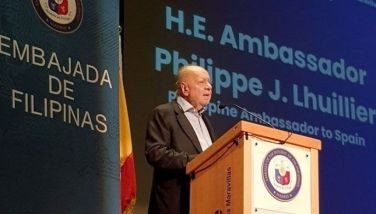Why collecting more cigarette taxes makes sense

The health of the nation continues to be a compelling reason why more cigarette taxes should be collected, and this has been the subject of several of my columns in the past.
Recently, I came across a study which cited University of the Philippines Dean and Professor of Law Marvic MVF Leonen as one of the authors that systematically tackled the issue of the ill-effects of tobacco smoking on the health budget.
As I had also written in this column before, the paper likewise noted the “popularity” of smoking in the Philippines not just among adults, but even with our youth despite the popular notion that this generation is more supportive of healthy and “green” living.
Accordingly, the country has 17.3 million adult smokers, which squarely puts us as having one of the highest smoking prevalence rates in the world. In fact, we are ranked 12th among males, and 5th among females. More alarmingly, the paper talks about the growing population of youth smokers, one that has increased by almost 40 percent during a span of four years.
Even if there is a law prohibiting sale to minors, at least a fourth of our youth has started to smoke. According to the 2000 Global Youth Tobacco Survey, there are even cases of children younger than 10 years old who have started to pick up the filthy habit.
Smoking ills raise health cost
No wonder then that the cost to our society because of smoking ills is also on the rise. An estimated 30,000 Filipinos die yearly of smoking-related illnesses, including diseases of the heart, nervous system, pulmonary system, and various cancers.
Another 30,000 people, second-hand smokers or individuals exposed to the smoke of those who drag on the nicotine of their cigars or cigarettes, are estimated to be afflicted by this smoking mania. Particularly vulnerable are children with asthma.
The cost of smoking to the country, both in terms of health care and productivity losses, is estimated to be between P220 to P460 billion. Worse, those affected belong to the lower levels of the income strata, and subsequently pose a higher burden on the public health care system.
14-year cigarette tax ‘incentive’
Anti-smoking advocates have been very vocal about the cost of cigarettes in the Philippines, one that has allowed even our high school students to set aside one or two pesos of their allowance for a stick to puff on after school hours.
Noting the unchallenged statistics of rising deaths and medical costs related to tobacco use, I have often nudged the Department of Health to take a bigger role in the campaign to raise levies on tobacco, particularly excise taxes, to at least cover government’s costs related to smoking health problems.
Several legislative measures have been filed to correct the existing excise tax for tobacco products. Currently, the cigarette excise tax structure has four levels depending on the net retail price per pack: low-priced, medium priced, high priced, and very high priced.
The existing law (RA8424), however, protects cigarette brands listed in the so-called Appendix D of the law by allowing these cigarettes brands to pay the lower excise tax based on their 1996 retail prices.
This current excise tax scheme which provided the “14 year old” arbitrary protection to brands that account for 90 percent of the cigarette market has been the main reason why the Philippines has one of the cheapest prices of cigarettes in the world, which ultimately contributes to the high growth rate in youth smoking and the high cost of public health care.
Graduated reform
In reforming the excise tax structure, the Leonen-penned paper strongly called for the removal of the price classification freeze, and shifting from multi-level to a single tax structure. It also urged for government to peg taxes to inflation, and if possible, on income growth while allowing for gradual increases in the excise tax.
What I liked best about the paper was its sensible approach to tax reform in response to the many issues posed by cigarette manufacturers against raising taxes on tobacco. Thus, the recommended approach to facilitate a relatively painless transition from the current to a new order would entail three stages.
The first stage, set for 2012, would entail removing the “14-year old” arbitrary price classification freeze, and reducing the tiers from four to three through a series of legislative and executive initiatives. Representative Neil Tupas Jr. of Iloilo has a bill along this line which is being deliberated in the House Ways and Means Committee.
The second stage aims to further decrease the number of tax tiers to two in 2013, or one year after the price classification freeze is lifted; and in the third stage, by 2014, the change to a single level tax structure.
Part of the third stage, which is proposed to take effect in 2015, will increase the uniform specific rate by at least 10 percent every year to compensate for inflation and increases in income, and to further reduce the consumption of cigarettes.
Re-allocation of cigarette tax revenues
Depending on how the market will react to the new taxes, the study approximates additional revenues of P18 billion to P26 billion on the first year alone, aside from helping reduce smoking prevalence by as much as 25 percent by 2016.
With the new money, the study recommends a review of the allocated funds from tobacco taxes. Firstly, instead of distributing part of the tax collections to the general funds of local governments in tobacco-producing provinces, the money should be earmarked specifically to promote alternative livelihood for tobacco farmers.
A portion of the collected taxes should likewise go to health promotion campaigns. On the national level, the agencies eyed are the DOH and the Department of Interior and Local Government. On the local level, health promotion may be undertaken by local health officials or boards.
The option to collect more taxes on cigarettes continues to be the most sensible alternative facing our current government, not just in terms of raising revenues but also confronting a costly malady of smoking that currently exists.
Will our legislators and political leaders, led by a self-confessed smoking habitué (our president, himself), champion such move for the good of the Filipino nation?
Should you wish to share any insights, write me at Link Edge, 25th Floor, 139 Corporate Center, Valero Street, Salcedo Village, 1227 Makati City. Or e-mail me at [email protected]. For a compilation of previous articles, visit www.BizlinksPhilippines.net.
- Latest
- Trending






























